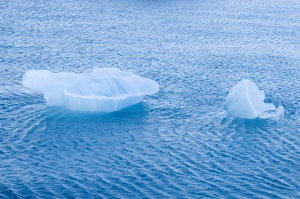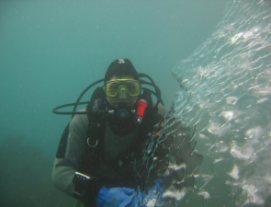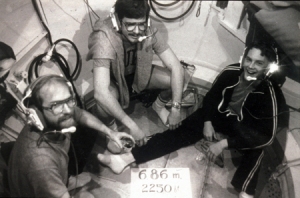When most people think of hydrogen, they think of the fuel that stars burn in their nuclear fires, the hydrogen bomb, or the Hindenburg disaster. Hydrogen is known for its combustibility and explosiveness.  Not many people would think of diving underwater with it.
Not many people would think of diving underwater with it.

So why would anyone consider breathing hydrogen? When diving deeper than a few meters, you need a so-called diluent gas to mix with oxygen. Air is a mixture of nitrogen and oxygen, and when compressed, that nitrogen becomes narcotic, leading to nitrogen narcosis, or “rapture of the deep”. When air is compressed it also becomes dense, making it more difficult to breathe than air is at the surface.
Helium, often used by deep diving Navy and technical divers, is less dense than nitrogen and therefore is easier to breathe at depth. Furthermore, it is not narcotic, so no more “rapture of the deep”.
But for seriously deep diving, greater than about 450 msw (~1500 fsw), even a mixture of helium and oxygen becomes dense enough to impede breathing. One solution is to use an even lighter gas, hydrogen.
Experimental hydrogen-helium-oxygen gas mixtures have been used by COMEX in France to slightly exceed, at 2290 fsw (701 msw), the U.S. deep diving record (2250 fsw, 686 msw) set using a mixture of helium, nitrogen and oxygen.
Hydrogen has one annoying property — it is narcotic. It is far less narcotic than hyperbaric nitrogen, and some narcosis seems to be necessary to counteract the deleterious effects of the High Pressure Nervous Syndrome (HPNS). However, unlike nitrogen narcosis, which is akin to mild alcohol intoxication, hydrogen narcosis is reported to be psychotropic, inducing at great depth altered realities akin to those produced by LSD.
I once was conducting medical research on a 450 msw dive at the German GUSI deep diving chamber, and one of the divers was a French diver who had been a subject on the French hydrogen dives. He reported, without going into detail, that he did not like the effects of hydrogen at all. It was strange, he said. On the other hand, the same diver did very well on the helium-nitrogen-oxygen gas mixture used at GUSI and Duke University.
That some exotic gases on deep experimental dives would be considered strange is an understatement. Deep hydrogen has been reported to produce out of body experiences, something that a person as well grounded as a professional diver would consider frighteningly bizarre.

The Swedes, and Arne Zetterström in particular, were interested in hydrogen diving during World War II for a simple reason; they wanted to dive deep, without the effects of nitrogen narcosis, but did not have access to helium. Most helium comes from gas wells in the United States and Russia. So, looking for another diluent gas other than helium, Zetterström briefly considered two constituents of intestinal gas (flatus), namely methane and hydrogen. Arguably, it was easy for the Swedes to produce plenty of methane and hydrogen. Just how they planned to do that is something I never asked.
Eventually, hydrogen was chosen for the Swedish dives simply because hydrogen was less dense than methane.
In principle, hydrogen could be used by a deep technical diver, but only at depths deeper than 132 fsw (5 atmospheres), a depth which would turn the noncombustible 4% oxygen in hydrogen gas mix into a so-called normoxic gas mixture, meaning it would have about as many oxygen molecules per breath as air at the surface. If the diver attempted to come shallower on that same gas mixture, he would lose consciousness due to hypoxia.
Since helium is not a combustible gas it does not have gas mixture restrictions. As long as a helium-oxygen gas mixture contains the right amount of oxygen (not too much and not too little), then it will be safe. Both nitrogen and helium are therefore far preferred over either of the flammable gases methane and hydrogen for use in breathing gas mixtures for diving.
Nevertheless, as divers continue to explore ways of diving deeper, it is certainly possible that hydrogen and other exotic gases may eventually play a role in deep life-support. Who knows, perhaps a perfect gas mixture will involve a blend of hydrogen and methane along with oxygen. If so, perhaps we could call it, oh I don’t know, maybe … Flatogen!







































